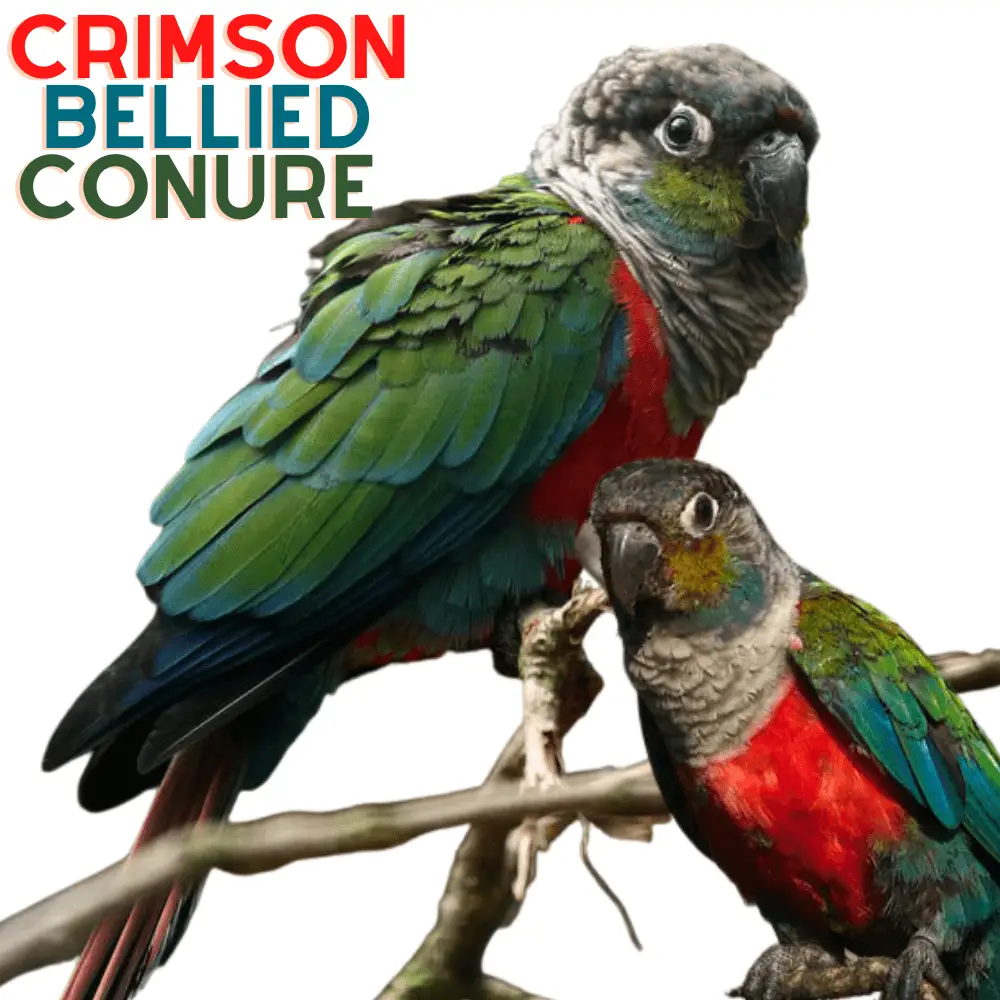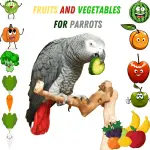
Red-bellied Parakeet or Pyrrhura perlata and also known as Crimson-bellied Parakeet, In adults, the cheeks are yellowish olives with a brown shade. The feathers of the forehead, hood, and back of the neck are dark slate-grey with buff endings, which gives these parts a mottled appearance.
It is even sharper on the nape of the neck where a little extra blue reinforces this impression. The top of the coat is blue, and the bottom of the coat and the blankets are green. The scapulars are green at the base, and blue at the ends. The small covers are olive-green, and the medium and large covers are mostly blue.
The feathers have a blue upper top, the secondary ones are green on the outer nets and dark slate-grey on the underside. The underwing covers are bright red.
Alternative names
- Crimson-bellied Parakeet, Crimson bellied Parakeet, Crimson-bellied Conure, Pearly Conure, Pearly Parakeet, Rose-bellied Conure, Rose-breasted Conure, Rose-breasted Parakeet (English).
- Red-bellied Parakeet, Beaded Parakeet, Red-bellied Parakeet, Crimson-breasted Parakeet, Red-bellied Parakeet (French).
- Rotbauchsittich, Blausteißsittich, Blausteiss-Sittich, Rotbauch-Sittich (German).
- Tiriba-de-barriga-vermelha (Portuguese).
- Catita cola granate, Cotorra Ventirroja, Cotorra Ventrirroja, Perico de Pecho Rojo, Perico Perla (Spanish).
- Catita cola granate (Paraguay).
The feathers on the sides of the neck, throat, and upper breast are brown with a few blue spots and some buff tips, giving them a slightly scaled appearance. The lower chest and most of the belly are crimson red. The flanks, thighs, and under tail covers are blue in color with a greenish wash. The top of the tail displays a burgundy color with a green base and a very thin blue tip. The underside of the tail is dark slate.
The bill is brownish-black. The bare skin around the eye is greyish-white. The irises are dark brown, the legs black-slate.
The sexes are identical. In juveniles, bright red is absent on the underparts. Scapulars sometimes have dark edges.
Red-bellied parrot Scientific classification
Name:Conure
- Order: Psittaciformes
- Family: Psittacidae
- Genus: Pyrrhura
- Scientific name: Pyrrhura perlata
- Protonimo: Aratinga
- Reign: Animal
- Fork: Chordata
- Subphylum: Vertebrate
- Class: Poultry
- Order: Psittaciformes
- Family: Psittacidae
- Gender: Pyrrhura
- Latin name:Pyrrhura perlata
- Weight: 80 to 102 g
- Waist: 24 cm
This parakeet measures about 24 cm with a mass of 80 to 102 g. The adult has a design of red scales on a brown background covering much of the head, back, and chest.
The feathers of the cheeks and throat have sky-blue reflections while her panties are azure gray and her feathers are blue. His brown iris eyes are surrounded by very marked white eye circles.
The bill is black with a well-developed wax and its legs are gray-pink. Unlike adults, young birds have predominantly green plumage with brown heads with azure reflections.
Natural habitat
This species occurs in secondary humid forests with dense vegetation in Brazil and northern Bolivia.
In the wild, it is mainly found in a restricted area of the
Northern Brazil is between the Amazon River, north of Mato Grosso, to the Rio Madeira and Tapajos rivers.
Red-bellied conures usually frequent rainforests that are not overgrown in northern Mato Grosso, these birds occupy the driest forests and are often observed near edges, in clearings, or in sparse patches being regenerated.
In eastern Bolivia, they are also found in forests dominated by fig trees.
Captivity
The Red-bellied Parakeet is extremely rare in captivity and is only present in a few farms, where it reproduces very well.
After acclimatization, it is a solid bird that can live in aviaries. She is quite fierce and yet quite reserved, curious, and playful, especially if they feel confident.
In captivity young birds quickly lose fear and can be very attached to their caretaker. It is noisy, especially in the morning, and sleeps in the nest.
It is very aggressive during the breeding season toward other birds. It will preferably be necessary to hold a couple in a metal aviary 3m long by 2m wide and 2m high with a night shelter of a minimum of 1.5m long for 1m wide and 2m high.
The nest box is placed in the shelter and will have as minimum dimensions 60 cm in height and 25 cm in internal diameter with an access hole of 7 cm.
On the bottom, a layer of wood chips is placed.
Longevity
This small parrot can live between 12 and 15 years.
Behavior
Red-bellied Parakeets are particularly noisy birds and emit calls that are virtually permanent when they fly between trees in the forest.
Red-bellied conures are gregarious and mostly live in small flocks. Red-bellied parakeets are mostly arboreal but they often descend along rivers and streams to bathe or quench their thirst.
When they are on the ground, they take clay from the soil and ingest it to facilitate their intestinal transit.
Singing voices and screams
Red-bellied conures are particularly noisy birds. They emit calls that are practically permanent when they flit between the trees of the forest. Their main call is usually described as a “tieww kritieww”. No additional information is available.
Feeding nutrition and diet
Red-bellied conures have an almost exclusively vegetarian diet and their menu includes catkins of the “trema micrantha” which is a shrub of disturbed areas, fruits of fig, eugenia, or pepper trees “Zanthoxylum”, flowers that they collect from trees of the genus Dioclea and whose nectar they consume.
Reproduction
The Red-bellied Parakeet breeds between August and October.
The nest is placed in a tree cavity, sometimes at a height not much higher than three meters above the ground. She will lay 3 to 6 eggs that she will incubate for about 25 days.
Young conures will leave the nest after 7-8 weeks. Even if the reproduction rate is not very high, it is increasingly found in captivity.
Status in the Natural State
Red-bellied conures are generally quite common, but they may be in slight decline due to habitat degradation.
Crimson bellied conure price
It sometimes seems realistic to get Red-bellied Parakeet babies for around 500 € – 1000 € but be careful an amateur could not die because can not take care of them very well at a critical age. the Crimson-bellied conure price with the average being about $750.
Crimson-bellied Conure vs Green-cheek Conure?
SOURCE: Parrot Bliss




















